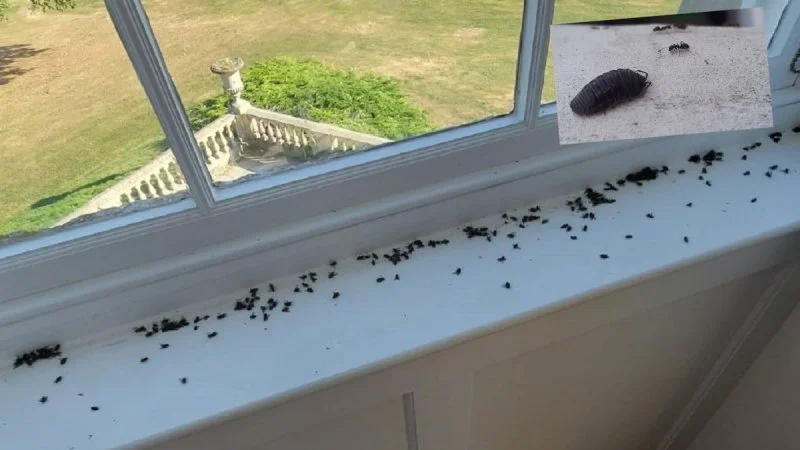Woodlice, often known as pill bugs or “armadillo bugs,” are small, harmless crustaceans commonly found in moist environments, typically outside in gardens or under rocks and logs. However, it’s not unusual to find them inside the home, particularly in areas like the basement, bathroom, or even upstairs. If you’ve discovered woodlice in house upstairs, you may be wondering how they got there and what you should do about them. In this article, we will explore the reasons woodlice enter your home, why they might be upstairs, and how to manage them effectively.
Why Are Woodlice in the House Upstairs?
Woodlice are attracted to environments with high humidity and decaying organic matter. While they usually thrive outdoors, woodlice in house upstairs may appear if conditions in your home mimic their natural habitat. This could be due to:
- Moisture: Areas with poor ventilation, such as bathrooms, kitchens, or rooms with plumbing issues, can create a damp environment where woodlice feel comfortable.
- Leaky Roofs or Windows: Water coming through leaks can lead woodlice to move to upper floors in search of moisture.
- Piles of Organic Matter: Woodlice are detritivores, meaning they feed on decaying organic matter. If there is wood, leaves, or other plant debris in an upstairs room, this can attract them.
The discovery of woodlice in house upstairs often indicates there may be a moisture problem or a source of organic material present that they can feed on.
How Do Woodlice Get Into Your Home?
Woodlice generally live outdoors, but they can make their way indoors if they find an entry point. Small cracks around windows, doors, or pipes are common access points. Once inside, they often stay near moisture sources. Woodlice in house upstairs may be there because they were able to slip through tiny gaps or holes in the walls or floors, making their way up to higher levels. This is especially common in homes with poor insulation or old windows.
Additionally, woodlice can hitch a ride inside with plants, firewood, or even via bags and clothing. It’s important to inspect items before bringing them inside to prevent unwelcome guests like woodlice in house upstairs.
Why Are Woodlice in the Upstairs Rooms?
Woodlice often prefer areas that provide them with high humidity, such as basements or ground-floor rooms. However, woodlice in house upstairs may indicate they’ve moved there due to high moisture or favorable conditions in the upper floors. Some factors that could attract woodlice to upstairs rooms include:
- Damp areas: If there’s a bathroom, kitchen, or attic with a moisture problem, woodlice might move upwards.
- Temperature: Upstairs rooms can sometimes be warmer, but if moisture is present, woodlice may find it a suitable environment.
- Food sources: Woodlice feeds on decaying organic material. If there is an accumulation of organic debris in an upstairs room, they might be drawn to it.
In these cases, woodlice in house upstairs are not uncommon and might simply be following the environmental cues they need to survive.
How to Deal with Woodlice in House Upstairs
While woodlice are harmless and don’t cause damage, seeing them in your home can be concerning. If you find woodlice in house upstairs, here are some steps you can take to address the issue:
- Reduce Moisture: Ensure that rooms upstairs have proper ventilation. Use dehumidifiers if necessary and fix any leaks in the plumbing or roof.
- Seal Entry Points: Inspect windows, doors, and walls for cracks or gaps and seal them to prevent woodlice from entering.
- Remove Food Sources: Clear away any decaying plant material, wood, or leaves that might attract woodlice.
- Use Traps: You can set up simple traps using a piece of damp newspaper. Woodlice are attracted to moisture, and they will gather under the newspaper, making it easy to remove them.
Preventing Woodlice in House Upstairs
To prevent future infestations of woodlice in house upstairs, consider these preventive measures:
- Improve Ventilation: Proper airflow can help reduce excess moisture in the home. Consider using exhaust fans in bathrooms and kitchens, especially on upper floors.
- Fix Leaks: Any leaks in the roof, windows, or plumbing should be repaired immediately to prevent moisture buildup.
- Inspect and Clean: Regularly inspect and clean areas that are prone to moisture, such as bathrooms, attics, and storage areas on the upper floors.
- Remove Outdoor Debris: Keep the area around your home clear of decaying leaves, wood, or other organic matter that might attract woodlice in the first place.
Conclusion: Dealing with Woodlice in Your Home
While finding woodlice in house upstairs might seem alarming, it’s generally not a cause for major concern. These small creatures are simply seeking out the damp, organic-rich environments they need to survive. By taking steps to reduce moisture, seal entry points, and clear food sources, you can manage and prevent woodlice infestations in your home. With a few proactive measures, you can ensure that woodlice stay outside where they belong.
Understanding the habits of woodlice and their attraction to moisture-rich areas can help you address the issue and keep your home woodlice-free.
FAQs About Woodlice in House Upstairs
1. Why are woodlice in my house upstairs?
Woodlice are attracted to moisture and decaying organic material. If your upstairs rooms have high humidity, leaks, or organic debris, it can draw woodlice inside.
2. How do woodlice get into my house upstairs?
Woodlice typically enters through small cracks or gaps around windows, doors, or pipes. They can also hitch a ride on plants, firewood, or clothing.
3. Are woodlice harmful in my house?
No, woodlice are harmless. They don’t bite, sting, or transmit diseases. They only cause concern because of their presence, but they don’t cause damage to structures.
4. How can I prevent woodlice from coming upstairs?
To prevent woodlice, reduce moisture levels in your upstairs rooms, fix any leaks, seal cracks, and remove decaying plant material that might attract them.

